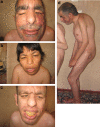An autosomal recessive syndrome of severe mental retardation, cataract, coloboma and kyphosis maps to the pericentromeric region of chromosome 4
- PMID: 18781183
- PMCID: PMC2985958
- DOI: 10.1038/ejhg.2008.159
An autosomal recessive syndrome of severe mental retardation, cataract, coloboma and kyphosis maps to the pericentromeric region of chromosome 4
Abstract
We report on three siblings with a novel mental retardation (MR) syndrome who were born to distantly related Iranian parents. The clinical problems comprised severe MR, cataracts with onset in late adolescence, kyphosis, contractures of large joints, bulbous nose with broad nasal bridge, and thick lips. Two patients also had uni- or bilateral iris coloboma. Linkage analysis revealed a single 10.4 Mb interval of homozygosity with significant LOD score in the pericentromeric region of chromosome 4 flanked by SNPs rs728293 (4p12) and rs1105434 (4q12). This interval contains more than 40 genes, none of which has been implicated in MR so far. The identification of the causative gene defect for this syndrome will provide new insights into the development of the brain and the eye.
Figures


Similar articles
-
A new locus for congenital cataract, microcornea, microphthalmia, and atypical iris coloboma maps to chromosome 2.Ophthalmology. 2009 Jan;116(1):154-162.e1. doi: 10.1016/j.ophtha.2008.08.044. Epub 2008 Nov 12. Ophthalmology. 2009. PMID: 19004499
-
Next generation sequencing in a family with autosomal recessive Kahrizi syndrome (OMIM 612713) reveals a homozygous frameshift mutation in SRD5A3.Eur J Hum Genet. 2011 Jan;19(1):115-7. doi: 10.1038/ejhg.2010.132. Epub 2010 Aug 11. Eur J Hum Genet. 2011. PMID: 20700148 Free PMC article.
-
A novel dysmorphic syndrome with open calvarial sutures and sutural cataracts maps to chromosome 14q13-q21.Hum Genet. 2003 Jul;113(1):1-9. doi: 10.1007/s00439-003-0932-6. Epub 2003 Apr 3. Hum Genet. 2003. PMID: 12677423
-
Iris coloboma, ptosis, hypertelorism, and mental retardation: a new syndrome possibly localised on chromosome 2.J Med Genet. 1991 May;28(5):342-4. doi: 10.1136/jmg.28.5.342. J Med Genet. 1991. PMID: 1865474 Free PMC article. Review.
-
Cytogenetic and clinical findings in a patient with a deletion of 16q23.1: first report of bilateral cataracts and a 16q deletion.Am J Med Genet. 1997 Dec 12;73(2):180-3. doi: 10.1002/(sici)1096-8628(1997)73:2<180::aid-ajmg13>3.0.co;2-q. Am J Med Genet. 1997. PMID: 9409869 Review.
Cited by
-
NRSF and BDNF polymorphisms as biomarkers of cognitive dysfunction in adults with newly diagnosed epilepsy.Epilepsy Behav. 2016 Jan;54:117-27. doi: 10.1016/j.yebeh.2015.11.013. Epub 2015 Dec 17. Epilepsy Behav. 2016. PMID: 26708060 Free PMC article.
-
Adult phenotype and further phenotypic variability in SRD5A3-CDG.BMC Med Genet. 2014 Jan 16;15:10. doi: 10.1186/1471-2350-15-10. BMC Med Genet. 2014. PMID: 24433453 Free PMC article.
-
Emerging Epidemiological Data on Rare Intellectual Disability Syndromes from Analyzing the Data of a Large Iranian Cohort.Arch Iran Med. 2023 Apr 1;26(4):186-197. doi: 10.34172/aim.2023.29. Arch Iran Med. 2023. PMID: 38301078 Free PMC article.
-
A novel cerebello-ocular syndrome with abnormal glycosylation due to abnormalities in dolichol metabolism.Brain. 2010 Nov;133(11):3210-20. doi: 10.1093/brain/awq261. Epub 2010 Sep 17. Brain. 2010. PMID: 20852264 Free PMC article.
-
Identification of a case of SRD5A3-congenital disorder of glycosylation (CDG1Q) by exome sequencing.Indian J Med Res. 2018 Apr;147(4):422-426. doi: 10.4103/ijmr.IJMR_820_16. Indian J Med Res. 2018. PMID: 29998879 Free PMC article. No abstract available.
References
-
- Leonard H, Wen X. The epidemiology of mental retardation: challenges and opportunities in the new millennium. Ment Retard Dev Disabil Res Rev. 2002;8:117–134. - PubMed
-
- van Karnebeek CD, Scheper FY, Abeling NG, et al. Etiology of mental retardation in children referred to a tertiary care center: a prospective study. Am J Ment Retard. 2005;110:253–267. - PubMed
-
- Najmabadi H, Motazacker MM, Garshasbi M, et al. Homozygosity mapping in consanguineous families reveals extreme heterogeneity of non-syndromic autosomal recessive mental retardation and identifies 8 novel gene loci. Hum Genet. 2007;121:43–48. - PubMed
-
- Kennedy GC, Matsuzaki H, Dong S, et al. Large-scale genotyping of complex DNA. Nat Biotechnol. 2003;21:1233–1237. - PubMed
Publication types
MeSH terms
LinkOut - more resources
Full Text Sources
Medical
Molecular Biology Databases
Miscellaneous

